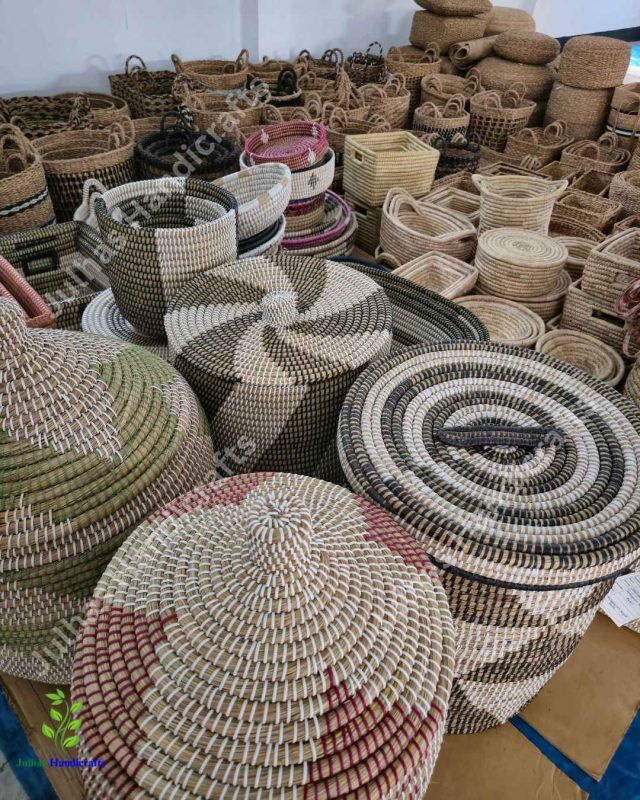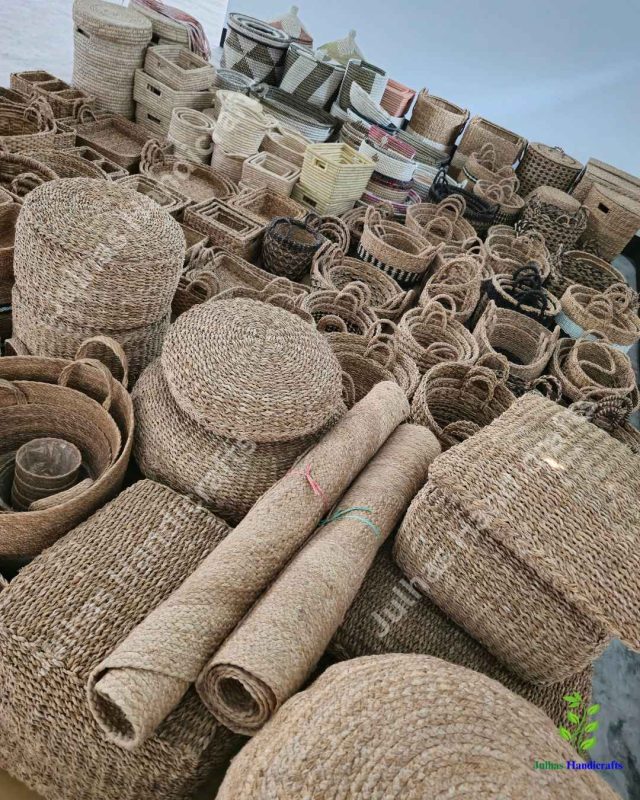The Story Behind Bangladeshi Handicrafts

Bangladesh’s handicrafts trace back centuries, rooted deeply in rural cottage industries and artisanal traditions. Handicrafts in this region include a vibrant array of materials and practices—jute, textiles, clay, brass, woodwork, embroidery, cane, bamboo, pottery, and more.
Some of the most iconic traditional crafts include:
- Handicrafts: A broad category that represents Bangladesh’s diverse traditional arts, ranging from functional household goods to decorative and cultural pieces that carry historical significance.
- Jamdani weaving: Originating in Narayanganj (South Rupshi region), this exquisite handloom fabric—once adored in Mughal courts—is now a UNESCO Intangible Cultural Heritage.
- Nakshi Kantha: Embroidered quilts with intricate motifs, typically made by rural women in places like Mymensingh, Rajshahi, and Jessore.
- Shataranji: A richly designed woven carpet from Rangpur, now a GI-tagged product reflecting aristocratic taste.
- Pottery, metalwork, brassware, wooden dolls, toys, cane products, embroidery (like Zamadani saris), woodwork, and more across regions like Sonargaon, Dhamrai, Comilla, Rajshahi, Narayanganj, and Barisal.
These crafts historically catered to both local daily needs and aristocratic patronage, with techniques and designs often passed down through generations. The sector plays a vital role in rural employment and cultural preservation.
Preservation & Revival
In recent years, there’s been a notable revival of traditional handicrafts in Bangladesh. Artisans are embracing modern designs, sustainable materials, and global platforms to preserve heritage while appealing to contemporary tastes.
Julhas Handicrafts: Bridging Tradition, Sustainability & Global Markets
Who We Are?
Founded in 2021, Julhas Handicrafts is a Bangladeshi handicraft export company specializing in eco-friendly, handcrafted products made from natural materials such as seagrass, jute, imam grass (kans grass), date leaf, palm fiber, and rattan.
They’re committed to artisan empowerment and sustainable production, holding industry-respected certifications like amfori BSCI and Sedex SMETA 4-pillar to ensure ethical sourcing and social responsibility.
- Julhas Handicrafts: The Best Handicrafts Exporter in Bangladesh
- Why Eco-Friendly Products Matter in 2025
Materials & Craft Techniques
Julhas harnesses readily available natural and renewable materials:
- Jute: Known as Bangladesh’s ‘golden fiber’, biodegradable and eco-friendly.
- Seagrass & Kans grass: Sourced sustainably, without pesticides or extensive water use.
- Date leaf, palm fiber, rattan: Traditional, renewable materials that support local agro-based economies.
Their production methods are predominantly hand-driven, or utilize simple tools, preserving centuries-old crafting techniques.
Craftsmanship & Product Range
Julhas Handicrafts boasts a catalog of 400+ unique designs, including baskets (laundry, storage, fruit, kitchen, garden), poufs, rugs, mats, doormats, placemats, hanging vases, bags, and more.



They are also responsive to customer needs, creating custom products while maintaining their core eco-conscious and artisan-rich ethos.
Certifications & Global Reach
Julhas is certified by:
- amfori BSCI (ethical trade practices)
- Sedex SMETA 4-Pillar (social and environmental responsibility)
- Export Promotion Bureau (EPB) of Bangladesh
- BANGLACRAFT (Bangladesh Handicrafts Manufacturer & Exporters Association)
Their international presence is evident in exhibitions like Ambiente (Frankfurt) in 2023, 2024, and 2025—one of the world’s premier trade fairs for consumer goods.
Impact & Contribution
Julhas has made notable contributions to the Bangladeshi handicrafts sector, such as:
- Supporting rural artisans by providing steady demand and fair working conditions.
- Promoting sustainability in accessory production through biodegradable, pesticide-free materials.
- Bringing traditional crafts to global markets, helping elevate Bangladesh’s profile in eco-conscious design and ethical manufacturing.
- Boosting employment and preserving traditional techniques through modern adaptation and export-growth strategies.
Conclusion
Bangladesh’s handicrafts are a vibrant tapestry of tradition, culture, and skilled craftsmanship. While they face challenges—market competition, fading artisan interest, and modernization pressures—the sector reveals remarkable resilience. Traditional crafts like Jamdani, Nakshi Kantha, Shataranji, and others continue to shape the national identity.
Julhas Handicrafts represents a forward-looking force within that tapestry: embracing environmental stewardship, ethical practices, and global outreach without losing touch with craftsmanship. They’re emblematic of how “handicrafts can mean heritage and innovation at once.”

